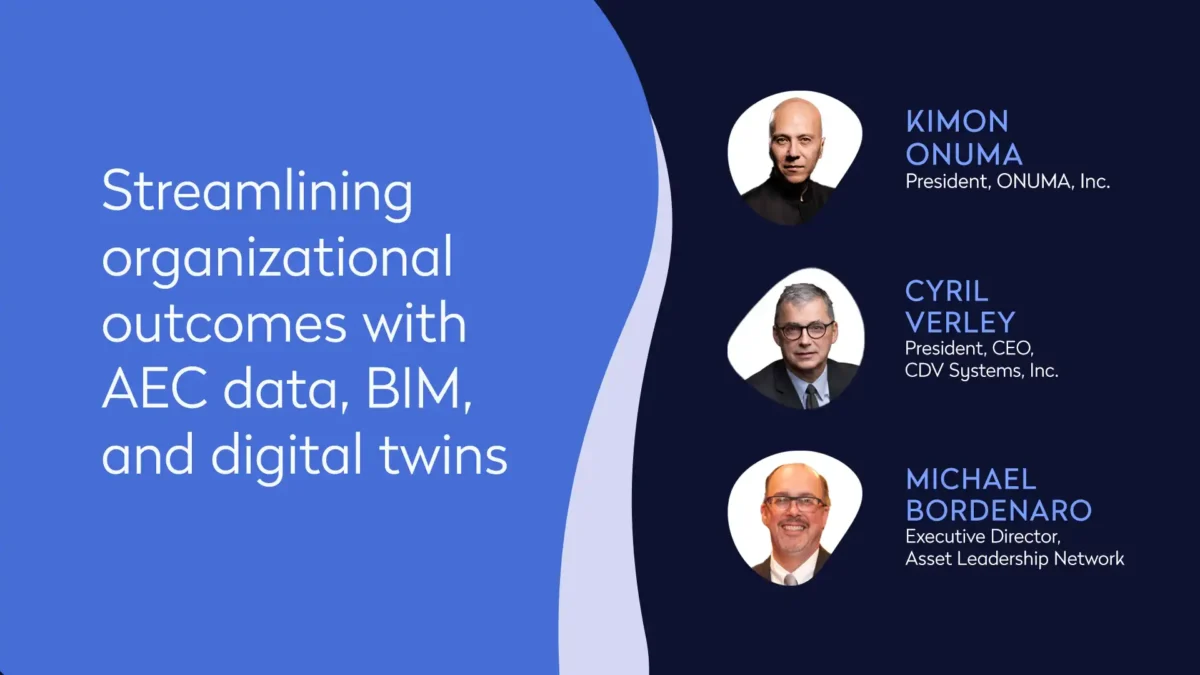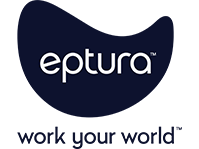
“Streamlining organizational outcomes with AEC data, BIM, and digital twins” features a panel of industry experts sharing insights and advice on how to make the most of organizational data. They look at different types, including architectural, engineering, and construction (AEC) and building information modeling (BIM), and cover concrete steps for leveraging artificial intelligence (AI) and digital twins in asset and facility management.
The panel includes:
- Kimon Onuma, President, ONUMA, Inc.
- Cyril Verley, President, CEO, CDV Systems, Inc.
- Michael Bordenaro, Executive Director, Asset Leadership Network
To help you get the most from watching the webinar, here’s an annotated recap with key takeaways, background, and further reading for a more complete understanding of the topics and their importance in modern asset and facility management.
Implementing digital twins and AI are crucial for efficient asset management, but the technologies are only part of the solution
Early in the webinar, Onuma starts by explaining that AI and digital twins are crucial for asset and facility management, but he is also careful to position them within the larger context of setting and achieving departmental and organizational goals.
“Technology is very important. It’s a foundation, but it’s not the starting point.”
Instead, he encourages organizations to decide first on what they are trying to accomplish, their specific use cases. From there, they can then find the platforms that best support these goals. Onuma explains: “You don’t buy a Ferrari if you just want to cross the street.”
Bordenaro agrees that the integration of data and technology is essential for efficient asset management, but leaders need to find ways to connect not only the data and tech but also their people.
“In order to deal with the human behavior that we have to overcome. It’s not the tools, it’s not the processes. It’s the mindset… leaders need to set up a culture of continual improvement because these tools are coming at us rapid fire.”
Background on AI and digital twins in asset and facility management
The panel covers a lot of ground and touches on important topics right at the start. Understanding the related industry trends can help better position and appreciate their insights.
How can organizations leverage AI for facility management?
Companies can add AI to many existing workflows, enhancing efficiency, reducing costs, and improving performance.
By feeding the software historical data and real-time sensor inputs, companies can use AI to forecast equipment failures before they occur, minimizing downtime and extending asset lifespans. By moving to predictive maintenance, organizations can see marked improvement over slower, more expensive reactive practices.
Facility teams can also use AI to optimize energy consumption. Smart building automation systems backed by AI can analyze energy usage patterns and adjust settings in real-time, maximizing efficiency. These systems can control lighting, heating, and cooling based on occupancy and weather conditions, leading to significant energy savings. AI also helps facility teams identify inefficiencies and recommend improvements.
Facility and office managers can leverage AI to enhance occupant comfort and productivity by personalizing workplace experiences. For example, AI-backed desk and room booking helps employees coordinate with coworkers for in-office days.
What are the benefits of a digital twin for asset and facility management?
A digital twin in asset and facility management is a dynamic virtual replica of a physical asset or system, designed to optimize performance and maintenance through real-time data analysis and simulation. Integrating Internet of Things (IoT) devices, AI, and machine learning, digital twins continuously collect data from sensors embedded in the physical asset, providing a comprehensive, up-to-date view of its operational status.
Organizations can leverage digital twins for proactive maintenance by forecasting potential issues, such as equipment failures, through predictive analytics. In facility management, they help optimize energy consumption, enhance occupant comfort, optimize operations, and improve safety by detecting anomalies and potential hazards in real-time. For asset management, digital twins offer insights into the lifecycle of equipment, aiding in informed decision-making about utilization, maintenance, and replacement strategies.
What are some best practices for change management when implementing new technologies?
Across industries, organizations often find implementing new technologies challenging. Best practices for change management can include:
Stakeholder engagement and buy-in: Engaging stakeholders early in the process helps to build support and ensures that their needs and concerns are addressed. People embrace changes once they can see how it benefits them directly.
Buy-in is critical to following Onuma’s advice to start not with technology but use cases. The only way to know how people will use the new technology is to ask them, and the best way to get good answers is to ensure they feel they have an investment in the project’s success.
For more information on the specific steps to take to generate use cases and build data-user personas, get the guide “BIM for FM: Bridging life cycle gaps is just the beginning.”
Comprehensive training and support: Providing adequate training and support is essential for ensuring that employees feel confident and competent in using the new technology.
One of the growing benefits of modern platforms is the focus on being user friendly, which means they require less training. For example, our Intelligent Worktech event includes announcements on how space planners will be able to deliver space reporting and occupancy management without being specialists in building design programs. With cross-platform connections, departments will bring the benefits of digital twin technology to their workflows — in some cases even without extensive Revit or 3D CAD training.
Data now has a central role in modern asset and facility management, but not all data is created equal
Data has value at every stage of a facility’s life cycle, from design and planning to operations and maintenance. But capturing it isn’t enough. Data must be consistent and transparent.
Verlay highlights the importance of a consistent data structure, even some something as simple as the way room are numbered in the data. “Consistent data structure from the very beginning… for existing or new projects,” while Bordenaro advocates for existing standards, specifically ISO.
Long-term, the goal should be to connect all the data, but the panel describes different organizations that have started simple and built from there. Part of the process is owners and other stakeholders demanding open connectivity across systems.
Onuma explains: You can start with the basics, as long as everyone has the same information, which reduces hallucinations. We talked about hallucinations in AI, but I say we’ve been hallucinating with facilities for decades because we don’t have access to good information. Which is the same problem we have with AI: If you don’t have good information, you start making stuff up.”
That said, the panel emphasizes the importance of simply starting the journey toward leveraging BIM data and digital twins. Organizations don’t need perfect data in high-tech platforms to start to gain value from their existing data, even if it’s incomplete and in a less desirable format.
Understanding important issues related to data in asset and facility management
The panel dives deep into data, so understanding the different types and ways to capture and control it delivers a better understanding of their advice.
What are the data types contained in BIM?
Across the facility life cycle, different departments and teams contribute to BIM data. Each type of data represents a different dimension of BIM.
- 3D – Three-dimensional: Spatial representation of the building, showing its geometry and design
- 4D – Time: Scheduling and time-related information to the model, allowing for better project planning and management
- 5D – Cost: Estimates and financial data, enabling more accurate budgeting and cost control
- 6D – Sustainability: Information about the building’s energy performance and environmental impact, supporting sustainable design and operation
- 7D – Facility management: Data focused on the operational phase of the building, providing data for maintenance, repairs, and overall facility management.
How does BIM help solve the issues related to data sharing across teams and over the facility life cycle?
BIM enhances data sharing across teams and throughout a facility’s life cycle by providing a centralized, digital building representation. BIM allows an organization to integrate all relevant data into a single model, serving as a shared resource for architects, engineers, contractors, and facility managers. Implementing BIM ensures everyone works from the same up-to-date information, reducing miscommunication and errors.
BIM facilitates real-time updates and access, enabling seamless collaboration and speeding up decision-making. Over the facility’s life cycle, BIM helps an organization maintain a comprehensive record of the building’s history, including design changes, construction details, and maintenance activities. Historical data is crucial for ongoing maintenance, renovations, and future expansions.
By providing a unified platform for data management, using BIM ensures all stakeholders have the information they need, when they need it. This leads to more efficient and effective facility management, especially when integrated with other technologies like IoT and digital twins.
What are AI hallucinations?
The panel does mention AI hallucinations, so it’s worth covering them in a quick side note. They refer to instances where an artificial intelligence system generates outputs that are confidently presented but factually incorrect or nonsensical. This phenomenon occurs because AI models, particularly large language models, predict the next word in a sequence based on patterns they’ve learned from vast amounts of data. However, they don’t truly understand context or possess real-world knowledge. Instead, they generate text that seems plausible but can sometimes be entirely made up.
Specific to facilities management, the idea is that just like an AI without enough data, facility teams can accidently make up “facts” about their facilities that lead to underperforming operations and maintenance strategies and poor allocation of resources.
What are the ISO building standards?
ISO 16739 is part of the broader ISO 16739 series. The full title is “Industry Foundation Classes (IFC) for data sharing in the construction and facility management industries.”
- Data sharing: Provides a framework for sharing data across different software applications used in the construction and facility management industries
- Interoperability: Aims to enhance interoperability between different BIM software tools, ensuring that data can be seamlessly exchanged and understood across various platforms
- IFC (Industry Foundation Classes): Defines a common data model known as IFC, which includes definitions for building elements, properties, and relationships.
- Life cycle management: Supports the entire life cycle of a building, from design and construction to operation and maintenance, by providing a consistent way to represent and exchange building information
- Global adoption: Widely adopted internationally, helping to standardize BIM practices and improve collaboration among global teams
By following ISO 16739, construction and facility management professionals can ensure that their BIM data is consistent, accurate, and easily shareable, leading to more efficient and effective project management.
What is the ISO 5500 standard?
The ISO 55000 series is an international standard for asset management. It provides a framework for organizations to optimize the management of their assets, ensuring they are safe, sustainable, and cost-effective throughout their lifecycle.
The series includes several parts:
ISO 55000: Outlines the overview, principles, and terminology of asset management. It provides a high-level introduction to the concepts and benefits of effective asset management
ISO 55001: Details what an organization needs to do to establish, implement, maintain, and improve an asset management system. Organizations can be certified against to demonstrate their compliance with the standard
ISO 55002: Provides guidelines for the implementation of an asset management system, offering practical advice and examples to help organizations meet the requirements of ISO 55001
The ISO 55000 series is applicable to any organization, regardless of its size, type, or industry. It helps organizations to align their asset management strategies with their overall business objectives, improve financial performance, enhance risk management, and achieve sustainable development goals.






